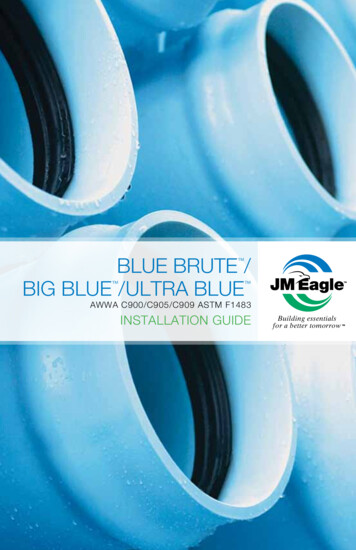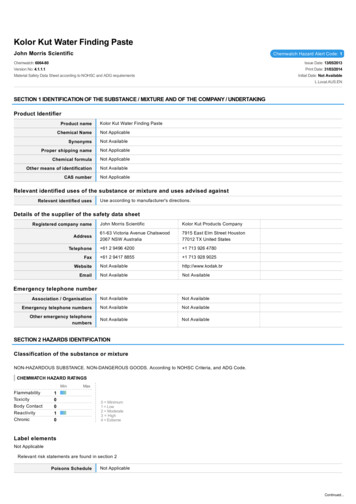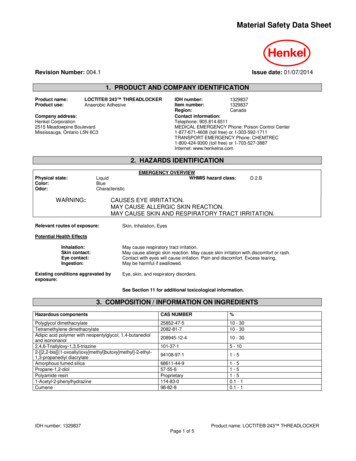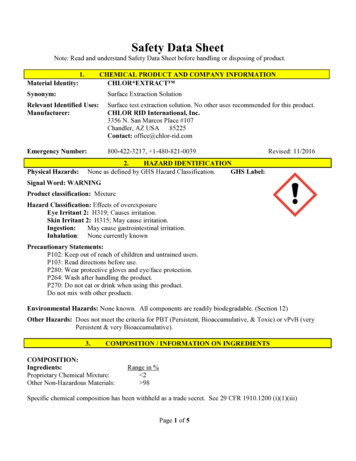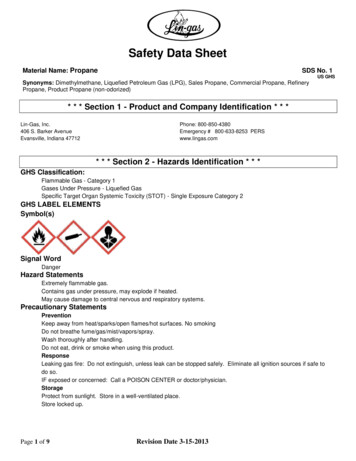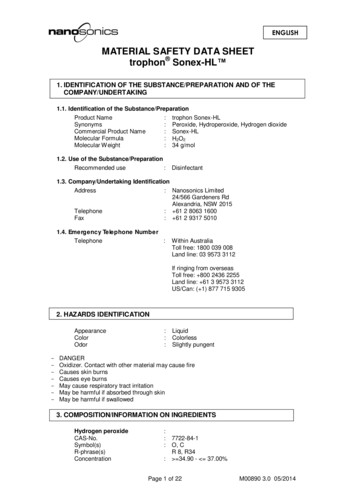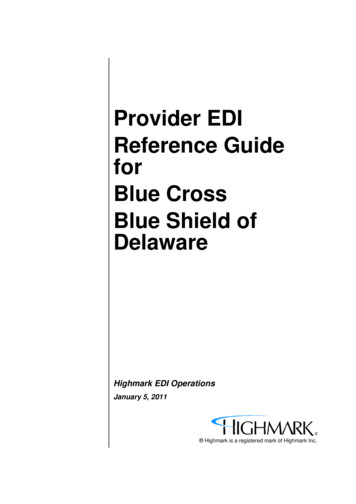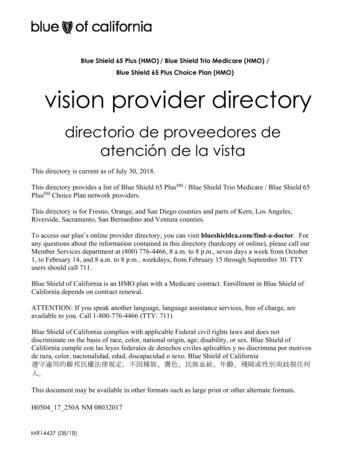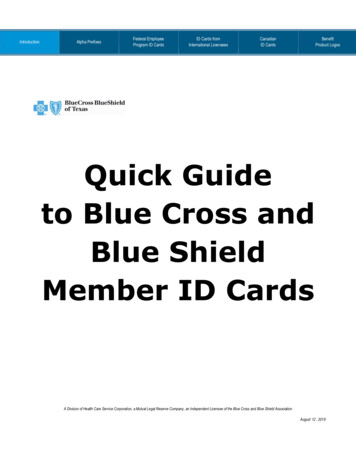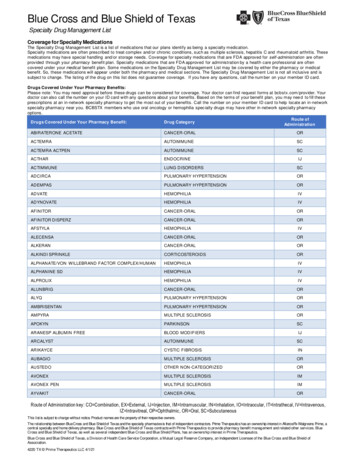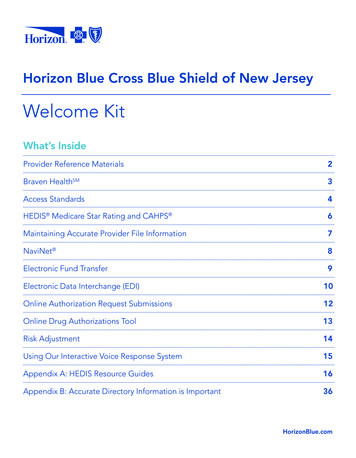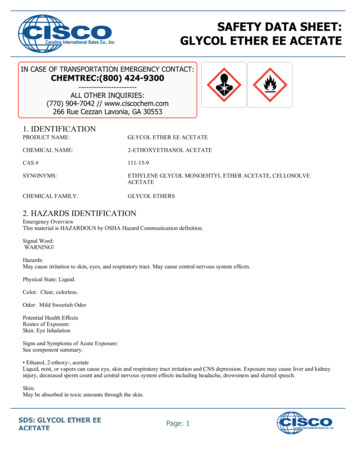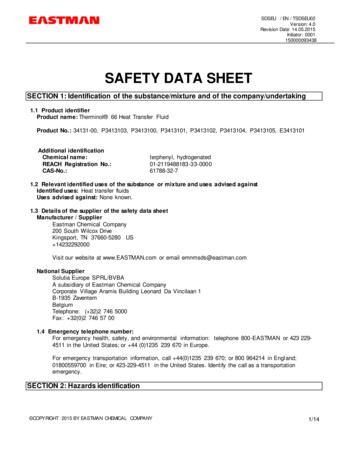
Transcription
SDSEU / EN / TSDSEU02Version: 4.0Revision Date: 14.05.2015Initiator: 0001150000093438SAFETY DATA SHEETSECTION 1: Identification of the substance/mixture and of the company/undertaking1.1 Product identifierProduct name: Therminol 66 Heat Transfer FluidProduct No.: 34131-00, P3413103, P3413100, P3413101, P3413102, P3413104, P3413105, E3413101Additional identificationChemical name:REACH Registration No.:CAS-No.:terphenyl, hydrogenated01-2119488183-33-000061788-32-71.2 Relevant identified uses of the substance or mixture and uses advised againstIdentified uses: Heat transfer fluidsUses advised against: None known.1.3 Details of the supplier of the safety data sheetManufacturer / SupplierEastman Chemical Company200 South Wilcox DriveKingsport, TN 37660-5280 US 14232292000Visit our website at www.EASTMAN.com or email emnmsds@eastman.comNational SupplierSolutia Europe SPRL/BVBAA subsidiary of Eastman Chemical CompanyCorporate Village Aramis Building Leonard Da Vincilaan 1B-1935 ZaventemBelgiumTelephone: ( 32)2 746 5000Fax: 32(0)2 746 57 001.4 Emergency telephone number:For emergency health, safety, and environmental information: telephone 800-EASTMAN or 423 2294511 in the United States; or 44 (0)1235 239 670 in Europe.For emergency transportation information, call 44(0)1235 239 670; or 800 964214 in Engl and;01800559700 in Eire; or 423-229-4511 in the United States. Identify the call as a transportationemergency.SECTION 2: Hazards identification COPYRIGHT 2015 BY EASTMAN CHEMICAL COMPANY1/14
SDSEU / EN / TSDSEU02Version: 4.0Revision Date: 14.05.2015Initiator: 00011500000934382.1 Classification of the substance or mixtureThe product has been classified according to the legislation in force.Regulation No. 1272/2008.Environmental HazardsChronic hazards to the aquaticenvironmentHazard summaryPhysical Hazards:Category 4Not classified as hazardous.Health HazardsInhalation:None known.Eye contact:None known.Skin contact:None known.Ingestion:None known.Other Health Effects:None known.Environmental hazards:H413: May cause long lasting harmful effects toaquatic life.May cause long lasting harmful effects to aquatic life.Classification according to Directive 67/548/EEC or 1999/45/EC as amended.R53: May cause long-term adverse effects in the aquatic environment.2.2 Label ElementsHazard Statement(s):H413: May cause long lasting harmful effects to aquatic life.Precautionary StatementPrevention:P273: Avoid release to the environment.Response:None.Disposal:P501: Dispose of contents/container to an appropriate treatment anddisposal facility in accordance with applicable laws and regulations,and product characteristics at time of disposal.2.3 Other hazards:Thermal burn hazard - contact with hot material may cause thermal burns. COPYRIGHT 2015 BY EASTMAN CHEMICAL COMPANY2/14
SDSEU / EN / TSDSEU02Version: 4.0Revision Date: 14.05.2015Initiator: 0001150000093438SECTION 3: Composition/information on ingredients3.1 SubstanceGeneral information:Chemical nameterphenyl, hydrogenatedConcentration100%Additional identificationCAS-No.: 61788-32-7EC No.: 262-967-7REACH Registration No.: 01-2119488183-330000NotesExplanation for Notes (if applicable):* All concentrations are percent by weight unless ingredient is a gas. Gas concentrations are in percent by volume.# This substance has w orkplace exposure limit(s).PBT: persistent, bioaccumulative and toxic substance.vPvB: very persistent and very bioaccumulative substance.ClassificationChemical nameterphenyl, hydrogenatedClassificationR53DSD:CLP:NotesAquatic Chronic 4, H413DSD: Directive 67/548/EEC.CLP: Regulation No. 1272/2008.:The full text for all R-phrases and H-statements is displayed in section 16.SECTION 4: First aid measuresGeneral:Get medical attention if symptoms occur. Show this safety data sheet to thedoctor in attendance. If breathing is difficult, give oxygen. If not breathing,give artificial respiration. Place unconscious person on the side in therecovery position and ensure breathing can take place. Ensure that medicalpersonnel are aware of the material(s) involved and take precautions toprotect themselves.4.1 Description of first aid measuresInhalation:Move into fresh air and keep at rest. For breathing difficulties, oxygen maybe necessary. Consult a physician for specific advice. Persons who haveinhaled vapours or smoke fumes have to be put under medical observationfor at least 48 hours, due to the delayed appearance of poisoning.Eye contact:Immediately flush with plenty of water for at least 15 minutes. If easy to do,remove contact lenses. Get medical attention if symptoms occur.Skin contact:Wash skin with soap and water. Get medical attention if symptoms occur.Wash contaminated clothing before reuse. Destroy or thoroughly cleancontaminated shoes. Wash with soap and water. Get medical attention ifsymptoms occur. COPYRIGHT 2015 BY EASTMAN CHEMICAL COMPANY3/14
SDSEU / EN / TSDSEU02Version: 4.0Revision Date: 14.05.2015Initiator: 0001150000093438Ingestion:4.2 Most important symptomsand effects, both acute anddelayed:If swallowed, rinse mouth with water (only if the person is conscious). Call aphysician or poison control center immediately. Do NOT induce vomiting.Never give liquid to an unconscious person. Provide fresh air, warmth andrest, preferably in comfortable upright sitting position. Loosen tight clothingsuch as a collar, tie, belt or waistband. If vomiting occurs, keep head low sothat stomach content doesn't get into the lungs.Contact with hot material can cause thermal burns which may result inpermanent damage.4.3 Indication of any immediate medical attention and special treatment neededHazards:None known.Treatment:Treat symptomatically. Persons who have inhaled vapours or smoke fumeshave to be put under medical observation for at least 48 hours, due to thedelayed appearance of poisoning.SECTION 5: Firefighting measuresGeneral Fire Hazards:5.1 Extinguishing mediaSuitable extinguishingmedia:Unsuitable extinguishingmedia:5.2 Special hazards arisingfrom the substance ormixture:5.3 Advice for firefightersSpecial fire fightingprocedures:Special protectiveequipment for fire-fighters:Promptly isolate the scene by removing all persons from the vicinity of theincident if there is a fire. Keep upwind. In case of fire and/or explosion donot breathe fumes.Water spray, foam, dry powder or carbon dioxide.Avoid water in straight hose stream; will scatter and spread fire.May ignite at high temperature. During fire, gases hazardous to healt h maybe formed. Risk of chemical pneumonia after aspiration. HazardousCombustion Products : carbon dioxide, carbon monoxide , soot .In case of fire: Evacuate area. Move container from fire area if it can bedone without risk. Use water spray to keep fire-exposed containers cool.Prevent runoff from fire control or dilution from entering streams, sewers, ordrinking water supply. Fire residues and contaminated fire extinguishingwater must be disposed of in accordance with local regulations.Self-contained breathing apparatus and full protective clothing must beworn in case of fire.SECTION 6: Accidental release measures COPYRIGHT 2015 BY EASTMAN CHEMICAL COMPANY4/14
SDSEU / EN / TSDSEU02Version: 4.0Revision Date: 14.05.2015Initiator: 00011500000934386.1 Personal precautions,protective equipment andemergency procedures:No action shall be taken involving any personal risk or without suitabletraining. Keep unauthorized personnel away. Ventilate closed spacesbefore entering them. Avoid inhalation of vapors and spray mists. Wearappropriate personal protective equipment. See Section 8 of the SDS forPersonal Protective Equipment. Caution: Contaminated surfaces may beslippery. Do not touch damaged containers or spilled material unlesswearing appropriate protective clothing.6.2 Environmental Precautions:Prevent further leakage or spillage if safe to do so. Avoid release to theenvironment. Clear up spills immediately and dispose of waste safely. Forwaste disposal, see section 13 of the SDS. Do not contaminate watersources or sewer.6.3 Methods and material forcontainment and cleaningup:Small Liquid Spills: Use a non-combustible material like vermiculite, sand orearth to soak up the product and place into a container for later disposal.Large Spillages: Dike for later disposal. Collect spillage in containers, sealsecurely and deliver for disposal according to local regulations. Otherwise,absorb spill with vermiculite or other inert material, then place in a containerfor chemical waste. Clean surface thoroughly to remove residualcontamination. Prevent runoff from entering drains, sewers, or streams.Notification Procedures:In the event of a spill or accidental release, notify relevant authorities inaccordance with all applicable regulations.SECTION 7: Handling and storage:7.1 Precautions for safehandling:Do not handle until all safety precautions have been read and understood.Handle product only in closed system or provide appropriate exhaustventilation at machinery. Avoid heat, sparks, open flames and other ignitionsources. An eye wash bottle must be available at the work site. Wearappropriate personal protective equipment. See Section 8 of the SDS forPersonal Protective Equipment. Do not taste or swallow. Do not breathemist or vapor from heated material. In case of inadequate ventilation, userespiratory protection. Do not get in eyes and avoid contact with skin andclothing. Wash promptly with soap and water if skin becomescontaminated. Remove contaminated clothing and wash it before reuse.Destroy or thoroughly clean contaminated shoes. Drain or removesubstance from equipment prior to break-in or maintenance. Handle inaccordance with good industrial hygiene and safety practice. See alsoSection 8 for additional information on hygiene measures.7.2 Conditions for safe storage,including anyincompatibilities:Store in a cool, dry place out of direct sunlight. Keep container tightlyclosed and in a well-ventilated place. Keep upright. Keep in originalcontainer. Store away from incompatible materials. Keep away from food,drink and animal feeding stuffs. Store in accordance withlocal/regional/national/international regulations.7.3 Specific end use(s):www.therminol.com/products/ COPYRIGHT 2015 BY EASTMAN CHEMICAL COMPANY5/14
SDSEU / EN / TSDSEU02Version: 4.0Revision Date: 14.05.2015Initiator: 0001150000093438SECTION 8: Exposure controls/personal protection8.1 Control ParametersOccupational Exposure LimitsCountry specific exposure limits have not been established or are not applicableunless listed below.DNEL-ValuesCritical componentterphenyl, hydrogenatedtypeWorkersterphenyl, hydrogenatedterphenyl, hydrogenatedterphenyl, hydrogenatedterphenyl, hydrogenatedterphenyl, hydrogenatedterphenyl, hydrogenatedterphenyl, hydrogenatedterphenyl, hydrogenatedRoute of Exposuresystemic, DNEL46,3 mg/kg bw/dayHuman, dermal, longterm (repeated):systemic, DNEL8,38 mg/m3Human, inhalation,long-term (repeated):local, DNEL Human, 0,2 mg/cm2dermal, long-term(repeated):local, DNEL Human, 83,8 mg/m3inhalation, long-term(repeated):General population systemic, DNEL27,8 mg/kg bw/dayHuman, dermal, longterm (repeated):systemic, DMEL0,3Human, Oral, LongTerm, Systemic:systemic, DNEL2,5 mg/m3Human, inhalation,long-term (repeated):local, DNEL Human, 0,123 mg/cm2dermal, long-term(repeated):local, DNEL Human, 25 mg/m3inhalation, long-term(repeated):RemarksA DNEL for acutetoxicity was not derivedbecause this material isnot acutely toxic and nopotential for high peakexposures exist.A DNEL for acutetoxicity was not derivedbecause this material isnot acutely toxic and nopotential for high peakexposures exist.PNEC-ValuesCritical componentterphenyl, hydrogenatedterphenyl, hydrogenatedterphenyl, hydrogenatedterphenyl, hydrogenatedEnvironmentalcompartmentAquatic (freshwater) 0,1 µg/lAquatic (marine0,01 µg/lwater)Aquatic (intermit.0,001 mg/lreleases)freshwater sediment 3,16 mg/kg COPYRIGHT 2015 BY EASTMAN CHEMICAL COMPANYRemarksdry6/14
SDSEU / EN / TSDSEU02Version: 4.0Revision Date: 14.05.2015Initiator: 0001150000093438terphenyl, hydrogenatedMarine sediments0,316 mg/kgdryterphenyl, hydrogenatedterphenyl, hydrogenatedSoil0,631 mg/kgdry10,3 mg/lterphenylterphenylSewage treatmentplantFresh watermarine waterterphenylterphenylfreshwater sediment 0,377 mg/kgMarine sediments0,038 mg/kgdrydryterphenylsoildry0,322 µg/l0,032 µg/l0,631 mg/kg8.2 Exposure controlsAppropriate engineeringcontrols:Good general ventilation (typically 10 air changes per hour) should be used.Ventilation rates should be matched to conditions. If applicable, useprocess enclosures, local exhaust ventilation, or other engineering controlsto maintain airborne levels below recommended exposure limits. Ifexposure limits have not been established, maintain airborne levels to anacceptable level.Individual protection measures, such as personal protective equipmentGeneral information:An eye wash bottle must be available at the work site. Provide access towashing facilities including soap, skin cleanser and fatty cream.Eye/face protection:Safety eyewear complying with an approved standard should be used whena risk assessment indicates this is necessary to avoid exposure to liquidsplashes, mists, gases or dusts. Recommendations: Wear safety glasseswith side shields (or goggles). Use safety goggles and face shield in case ofsplash risk. COPYRIGHT 2015 BY EASTMAN CHEMICAL COMPANY7/14
SDSEU / EN / TSDSEU02Version: 4.0Revision Date: 14.05.2015Initiator: 0001150000093438Skin protectionHand Protection:Other:If prolonged or repeated contact is likely, chemical resistant gloves arerecommended. If contact with forearms is likely, wear gauntlet style gloves.After contamination with product change the gloves immediately anddispose of them according to relevant national and local regulations. Pleaseobserve the instructions regarding permeability and breakthrough timewhich are provided by the supplier of the gloves. Also take intoconsideration the specific local conditions under
Product name: Therminol 66 Heat Transfer Fluid Product No.: 34131-00, P3413103, P3413100, P3413101, P3413102, P3413104, P3413105, E3413101 Additional identification File Size: 301KBPage Count: 14
